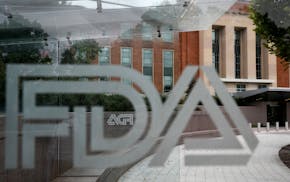Cargill Inc. is big in aquaculture feed, and salmon makes up one of the world's biggest aquaculture markets. But the fish feeder and the pink-fleshed fish haven't been in the same boat — until now.
Cargill's $1.5 billion acquisition of EWOS, which closed last month, gave the Minnetonka-based agribusiness giant an immediate and large presence in the world's salmon feeding business.
Cargill and Skretting, a Dutch company, each hold about one-third of the salmon feed market.
"Every third fish is fed by EWOS," said Einar Wathne, EWOS' former CEO and now president of Cargill Aqua Nutrition. Since wild-caught salmon doesn't come close to meeting global consumer demand, the market "is completely dominated by farmed salmon," he said.
Wathne is based in Bergen, Norway, EWOS' hometown and ground zero for the Atlantic salmon trade. He spoke with the Star Tribune recently at Cargill's offices in Hopkins.
Cargill's EWOS acquisition is eclipsed in size only by its $2.1 billion buyout in 2011 of Provimi, a Dutch animal feed company. Both deals show the importance of animal feed, one of Cargill's largest global businesses with more than 20,000 employees. With EWOS, Cargill took in about 1,000 more workers at seven global fish feed factories.
While Cargill will be busy integrating EWOS over the next couple of years, the company may eventually move directly into farming fish itself.
Aquaculture makes up only about 10 percent of the global animal feed business, but it's by far the fastest-growing market for the sector.
The world is increasingly turning to fish for protein, and aquaculture is vital to meet demand without stressing wild fisheries. Aquaculture accounted for 43.1 percent of world fish production in 2013, up from 30.6 percent in 2003, according to the United Nations Food and Agriculture Organization.
Until the EWOS deal, Cargill's aquaculture business focused on tilapia, shrimp and other warm-water creatures, particularly in Latin America and Asia. Salmon farming — done primarily in waters off Chile, Canada, Norway and Scotland — is in a league of its own.
Salmon, which in fish farming usually means Atlantic salmon, take twice as much time to grow as tilapia. They entail more complicated logistics, too. Since they're housed in cages out at sea, not in shore-side pens like tilapia, vessels are required to ferry out feed.
A large salmon farm might have five cages, each filled with 200,000 fish. That density has troubled environmentalists, who fear water pollution and the spread of sea lice from farmed fish to wild salmon. Sea lice are parasites that can cause lesions and immune system stress.
The lice are a big threat to farmed salmon, too, and vanquishing them is one of the industry's biggest challenges, Wathne said. EWOS has been working to tame sea lice through its salmon feed recipes.
Another big challenge for aquaculture feed makers is reducing the amount of fish in salmon feed.
Salmon in nature are hunters, eating other fish or crustaceans. So they are fed fishmeal, which is made from fish byproducts — trimmings and offal — as well as small fish like anchovies. However, turning anchovies and other live fish into fishmeal stresses wild fish populations.
The industry has been working to increase the amount of vegetable protein in salmon feed, which comes in little pellets. Vegetable matter, often from soybeans, makes up about 35 percent of salmon feed these days, a big increase.
Over the past 15 years, the salmon feed industry has essentially doubled production using the same amount of fishmeal. "We have reduced our dependence on marine protein," Wathne said. "That's one big improvement."
Fish are particularly efficient at converting feed into flesh. It takes only 1.2 pounds of feed to produce one pound of salmon, according to the U.S. National Oceanic and Atmospheric Administration. That compares to 1.9 pounds of feed for a pound of chicken, 5.9 pounds for a pound of pork and 8.7 pounds for a pound of beef.
For consumers, salmon is "premium protein" that competes with other meats, Wathne said. "Globally, we have had a fantastic and stable growth of salmon consumption."
Mike Hughlett • 612-673-7003

Senate passes bill forcing TikTok's parent company to sell or face ban, sends to Biden for signature
USPS commits to rerouting Reno-area mail despite bipartisan pushback and mail ballot concerns

